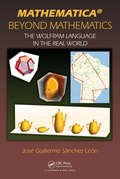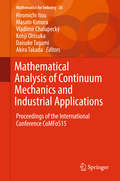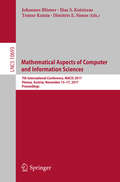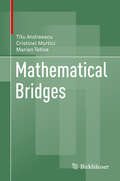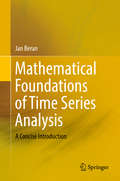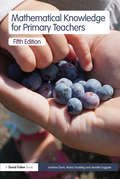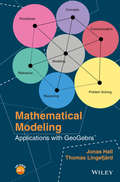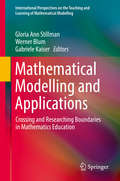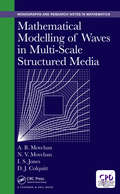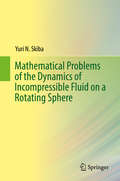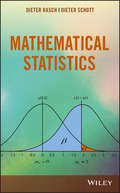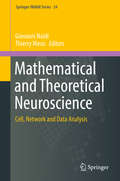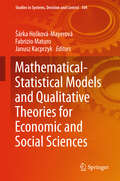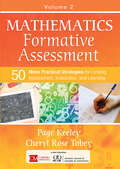- Table View
- List View
Mathematica Beyond Mathematics: The Wolfram Language in the Real World
by José Guillermo Sánchez LeónAlthough many books have been written about Mathematica, very few of them cover the new functionality added to the most recent versions of the program. Mathematica Beyond Mathematics: The Wolfram Language in the Real World introduces the new features using real-world examples, based on the experience of the author as a consultant. In the process, you will also learn more about the Wolfram Language and how you can use it to solve a wide variety of problems. The author raises questions from a wide range of topics and answers them by taking full advantage of Mathematica's latest features. For example; What sources of energy does the world really use? How can we calculate tolerance limits in manufacturing processes? Are our cities getting warmer? Is the novel El Quijote written in Pi? How can we find planets outside our solar system?
Mathematical Analysis of Continuum Mechanics and Industrial Applications
by Masato Kimura Hiromichi Itou Vladimír Chalupecký Kohji Ohtsuka Daisuke Tagami Akira TakadaThis book focuses on mathematical theory and numerical simulation related to various aspects of continuum mechanics, such as fracture mechanics, elasticity, plasticity, pattern dynamics, inverse problems, optimal shape design, material design, and disaster estimation related to earthquakes. Because these problems have become more important in engineering and industry, further development of mathematical study of them is required for future applications. Leading researchers with profound knowledge of mathematical analysis from the fields of applied mathematics, physics, seismology, engineering, and industry provide the contents of this book. They help readers to understand that mathematical theory can be applied not only to different types of industry, but also to a broad range of industrial problems including materials, processes, and products.
Mathematical Aspects of Computer and Information Sciences
by Ilias S. Kotsireas Johannes Blömer Temur Kutsia Dimitris E. SimosThis book constitutes the refereed proceedings of the 7th International Conference on Mathematical Aspects of Computer and Information Sciences, MACIS 2017, held in Vienna, Austria, in November 2017. The 28 revised papers and 8 short papers presented were carefully reviewed and selected from 67 submissions. The papers are organized in the following topical sections: foundation of algorithms in mathematics, engineering and scientific computation; combinatorics and codes in computer science; data modeling and analysis; and mathematical aspects of information security and cryptography.
Mathematical Bridges
by Titu Andreescu Cristinel Mortici Marian TetivaBuilding bridges between classical results and contemporary nonstandard problems, this highly relevant work embraces important topics in analysis and algebra from a problem-solving perspective. The book is structured to assist the reader in formulating and proving conjectures, as well as devising solutions to important mathematical problems by making connections between various concepts and ideas from different areas of mathematics. Instructors and motivated mathematics students from high school juniors to college seniors will find the work a useful resource in calculus, linear and abstract algebra, analysis and differential equations. Students with an interest in mathematics competitions must have this book in their personal libraries.
Mathematical Foundations of Time Series Analysis: A Concise Introduction
by Jan BeranThis book provides a concise introduction to the mathematical foundations of time series analysis, with an emphasis on mathematical clarity. The text is reduced to the essential logical core, mostly using the symbolic language of mathematics, thus enabling readers to very quickly grasp the essential reasoning behind time series analysis. It appeals to anybody wanting to understand time series in a precise, mathematical manner. It is suitable for graduate courses in time series analysis but is equally useful as a reference work for students and researchers alike.
Mathematical Knowledge for Primary Teachers
by Andrew Davis Jennifer Suggate Maria GouldingNow in its fifth edition, the best-selling text Mathematical Knowledge for Primary Teachers provides trainee teachers with clear information about the fundamental mathematical ideas taught in primary schools. With rigorous and comprehensive coverage of all the mathematical knowledge primary teachers need, the text goes beyond rules and routines to help readers deepen their understanding of mathematical ideas and increase their confidence in teaching these ideas. The book has been updated to incorporate changes in the National Curriculum and the associated tests. In addition, Chapter 1 has been expanded to discuss mathematical understanding in the light of the challenges posed by the current changes. These include the re-introduction of traditional calculation methods for multiplication and division, the early coverage of abstract fractions calculations and much more. Features include: ? ‘Check’ questions to test the reader’s understanding ? ‘Challenges’ to increase teachers’ confidence and stretch their mathematical abilities ? ‘Links with the classroom’ to emphasise the relevance of ideas to the classroom context ? Straightforward coverage from theory to practice for all aspects of the Mathematics Framework. The book is accompanied by a website which contains further visual activities and support, designed to scaffold and support the reader’s own understanding. Essential reading for all practising and trainee primary teachers, this book is ideal for those who wish to increase their mathematical understanding and confidence in presenting mathematics in the classroom.
Mathematical Methods in Chemical and Biological Engineering
by Binay Kanti DuttaMathematical Methods in Chemical and Biological Engineering describes basic to moderately advanced mathematical techniques useful for shaping the model-based analysis of chemical and biological engineering systems. Covering an ideal balance of basic mathematical principles and applications to physico-chemical problems, this book presents examples drawn from recent scientific and technical literature on chemical engineering, biological and biomedical engineering, food processing, and a variety of diffusional problems to demonstrate the real-world value of the mathematical methods. Emphasis is placed on the background and physical understanding of the problems to prepare students for future challenging and innovative applications.
Mathematical Modeling: Applications with GeoGebra
by Jonas Hall Thomas LingefjärdA logical problem-based introduction to the use of GeoGebra for mathematical modeling and problem solving within various areas of mathematics A well-organized guide to mathematical modeling techniques for evaluating and solving problems in the diverse field of mathematics, Mathematical Modeling: Applications with GeoGebra presents a unique approach to software applications in GeoGebra and WolframAlpha. The software is well suited for modeling problems in numerous areas of mathematics including algebra, symbolic algebra, dynamic geometry, three-dimensional geometry, and statistics. Featuring detailed information on how GeoGebra can be used as a guide to mathematical modeling, the book provides comprehensive modeling examples that correspond to different levels of mathematical experience, from simple linear relations to differential equations. Each chapter builds on the previous chapter with practical examples in order to illustrate the mathematical modeling skills necessary for problem solving. Addressing methods for evaluating models including relative error, correlation, square sum of errors, regression, and confidence interval, Mathematical Modeling: Applications with GeoGebra also includes: Over 400 diagrams and 300 GeoGebra examples with practical approaches to mathematical modeling that help the reader develop a full understanding of the content Numerous real-world exercises with solutions to help readers learn mathematical modeling techniques A companion website with GeoGebra constructions and screencasts Mathematical Modeling: Applications with GeoGebrais ideal for upper-undergraduate and graduate-level courses in mathematical modeling, applied mathematics, modeling and simulation, operations research, and optimization. The book is also an excellent reference for undergraduate and high school instructors in mathematics.
Mathematical Modelling and Applications
by Gabriele Kaiser Werner Blum Gloria Ann StillmanThis volume documents on-going research and theorising in the sub-field of mathematics education devoted to the teaching and learning of mathematical modelling and applications. Mathematical modelling provides a way of conceiving and resolving problems in the life world of people whether these range from the everyday individual numeracy level to sophisticated new problems for society at large. Mathematical modelling and real world applications are considered as having potential for multi-disciplinary work that involves knowledge from a variety of communities of practice such as those in different workplaces (e. g. , those of educators, designers, construction engineers, museum curators) and in different fields of academic endeavour (e. g. , history, archaeology, mathematics, economics). From an educational perspective, researching the development of competency in real world modelling involves research situated in crossing the boundaries between being a student engaged in modelling or mathematical application to real word tasks in the classroom, being a teacher of mathematical modelling (in or outside the classroom or bridging both), and being a modeller of the world outside the classroom. This is the focus of many of the authors of the chapters in this book. All authors of this volume are members of the International Community of Teachers of Mathematical Modelling (ICTMA), the peak research body into researching the teaching and learning of mathematical modelling at all levels of education from the early years to tertiary education as well as in the workplace.
Mathematical Modelling of Waves in Multi-Scale Structured Media (Chapman & Hall/CRC Monographs and Research Notes in Mathematics)
by Alexander B. Movchan Natasha V. Movchan Ian S. Jones Daniel J. ColquittMathematical Modelling of Waves in Multi-Scale Structured Media presents novel analytical and numerical models of waves in structured elastic media, with emphasis on the asymptotic analysis of phenomena such as dynamic anisotropy, localisation, filtering and polarisation as well as on the modelling of photonic, phononic, and platonic crystals.
Mathematical Problems of the Dynamics of Incompressible Fluid on a Rotating Sphere
by Yuri N. SkibaThis book presents selected mathematical problems involving the dynamics of a two-dimensional viscous and ideal incompressible fluid on a rotating sphere. In this case, the fluid motion is completely governed by the barotropic vorticity equation (BVE), and the viscosity term in the vorticity equation is taken in its general form, which contains the derivative of real degree of the spherical Laplace operator.This work builds a bridge between basic concepts and concrete outcomes by pursuing a rich combination of theoretical, analytical and numerical approaches, and is recommended for specialists developing mathematical methods for application to problems in physics, hydrodynamics, meteorology and geophysics, as well for upper undergraduate or graduate students in the areas of dynamics of incompressible fluid on a rotating sphere, theory of functions on a sphere, and flow stability.
Mathematical Statistics
by Dieter Rasch Dieter SchottExplores mathematical statistics in its entirety—from the fundamentals to modern methods This book introduces readers to point estimation, confidence intervals, and statistical tests. Based on the general theory of linear models, it provides an in-depth overview of the following: analysis of variance (ANOVA) for models with fixed, random, and mixed effects; regression analysis is also first presented for linear models with fixed, random, and mixed effects before being expanded to nonlinear models; statistical multi-decision problems like statistical selection procedures (Bechhofer and Gupta) and sequential tests; and design of experiments from a mathematical-statistical point of view. Most analysis methods have been supplemented by formulae for minimal sample sizes. The chapters also contain exercises with hints for solutions. Translated from the successful German text, Mathematical Statistics requires knowledge of probability theory (combinatorics, probability distributions, functions and sequences of random variables), which is typically taught in the earlier semesters of scientific and mathematical study courses. It teaches readers all about statistical analysis and covers the design of experiments. The book also describes optimal allocation in the chapters on regression analysis. Additionally, it features a chapter devoted solely to experimental designs. Classroom-tested with exercises included Practice-oriented (taken from day-to-day statistical work of the authors) Includes further studies including design of experiments and sample sizing Presents and uses IBM SPSS Statistics 24 for practical calculations of data Mathematical Statistics is a recommended text for advanced students and practitioners of math, probability, and statistics.
Mathematical Thermodynamics of Complex Fluids: Cetraro, Italy 2015 (Lecture Notes in Mathematics #2200)
by Eduard Feireisl Elisabetta Rocca John M. Ball Felix OttoEduard FeireislThe main goal of this book is to provide an overview of the state of the art in the mathematical modeling of complex fluids, with particular emphasis on its thermodynamical aspects. The central topics of the text, the modeling, analysis and numerical simulation of complex fluids, are of great interest and importance both for the understanding of various aspects of fluid dynamics and for its applications to special real-world problems. New emerging trends in the subject are highlighted with the intent to inspire and motivate young researchers and PhD students.
Mathematical and Theoretical Neuroscience: Cell, Network And Data Analysis (Springer INdAM #24)
by Giovanni Naldi Thierry NieusThis volume gathers contributions from theoretical, experimental and computational researchers who are working on various topics in theoretical/computational/mathematical neuroscience. The focus is on mathematical modeling, analytical and numerical topics, and statistical analysis in neuroscience with applications. The following subjects are considered: mathematical modelling in Neuroscience, analytical and numerical topics; statistical analysis in Neuroscience; Neural Networks; Theoretical Neuroscience. The book is addressed to researchers involved in mathematical models applied to neuroscience.
Mathematical-Statistical Models and Qualitative Theories for Economic and Social Sciences
by Janusz Kacprzyk Šárka Hošková-Mayerová Fabrizio MaturoThis book presents a broad spectrum of problems related to statistics, mathematics, teaching, social science, and economics as well as a range of tools and techniques that can be used to solve these problems. It is the result of a scientific collaboration between experts in the field of economic and social systems from the University of Defence in Brno (Czech Republic), G. d'Annunzio University of Chieti-Pescara (Italy), Pablo de Olavid eUniversity of Sevilla (Spain), and Ovidius University in Constanţa, (Romania). The studies included were selected using a peer-review process and reflect heterogeneity and complexity of economic and social phenomena. They and present interesting empirical research from around the globe and from several research fields, such as statistics, decision making, mathematics, complexity, psychology, sociology and economics. The volume is divided into two parts. The first part, "Recent trends in mathematical and statistical models for economic and social sciences", collects papers on quantitative matters, which propose mathematical and statistical models for social sciences, economics, finance, and business administration. The second part, "Recent trends in qualitative theories for economic and social sciences", includes papers on qualitative matters, which discuss social, economic, and teaching issues. It is an ideal reference work for all those researchers interested in recent quantitative and qualitative tools. Covering a wide range of topics, it appeals in equal measure to mathematicians, statisticians, sociologists, philosophers, and specialists in the fields of communication, social and political sciences.
Mathematics Formative Assessment, Volume 2: 50 More Practical Strategies for Linking Assessment, Instruction, and Learning (Corwin Mathematics Series)
by Cheryl Rose Tobey Page D. KeeleyEverything you need to promote mathematical thinking and learning! Good math teachers have a robust repertoire of strategies to move students’ learning forward. This new volume from award-winning author Page Keeley and mathematics expert Cheryl Rose Tobey helps you improve student outcomes with 50 all-new formative assessment classroom techniques (FACTS) that are embedded throughout a cycle of instruction. Descriptions of how the FACTs promote learning and inform teaching, including illustrative examples, support the inextricable link between instruction and learning. Useful across disciplines, Keeley and Tobey’s purposeful assessment techniques help K-12 math teachers: Promote conceptual understanding Link techniques to core ideas and practices Modify instruction for diverse learners Seamlessly embed formative assessment throughout the stages of instruction Focus on learning targets and feedback Instead of a one-size fits all approach, you can build a bridge between your students’ initial ideas and correct mathematical thinking with this one-of-a-kind resource!
Mathematics Formative Assessment, Volume 2: 50 More Practical Strategies for Linking Assessment, Instruction, and Learning (Corwin Mathematics Series)
by Cheryl Rose Tobey Page D. KeeleyEverything you need to promote mathematical thinking and learning! Good math teachers have a robust repertoire of strategies to move students’ learning forward. This new volume from award-winning author Page Keeley and mathematics expert Cheryl Rose Tobey helps you improve student outcomes with 50 all-new formative assessment classroom techniques (FACTS) that are embedded throughout a cycle of instruction. Descriptions of how the FACTs promote learning and inform teaching, including illustrative examples, support the inextricable link between instruction and learning. Useful across disciplines, Keeley and Tobey’s purposeful assessment techniques help K-12 math teachers: Promote conceptual understanding Link techniques to core ideas and practices Modify instruction for diverse learners Seamlessly embed formative assessment throughout the stages of instruction Focus on learning targets and feedback Instead of a one-size fits all approach, you can build a bridge between your students’ initial ideas and correct mathematical thinking with this one-of-a-kind resource!
